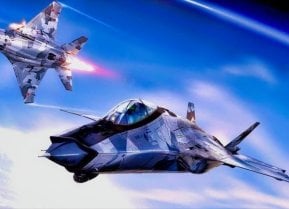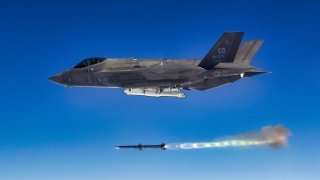Can the Astounding F-35 Drop Nuclear Weapons?
Since the F-35A is set to replace the current legacy jets in most NATO states that would take part in nuclear sharing, progress on the B61-12 front may coincide with NATO’s nuclear sharing arrangement down the line.
Can F-35s drop nuclear weapons? Last month, the Netherlands announced that its fleet of F-35A fighter jets had moved one step closer to becoming nuclear-capable airframes.
According to the announcement, some North Atlantic Treaty Organization-operated jets have received “initial certification for the deterrence mission.”
The commander of the Dutch Air Combat Command took to social media to announce the potentiality of NATO nuclear sharing, which would be historic. In the post, Johan van Deventer shared photographs of an F-35A test fighter equipped with test versions of the B61-12 bomb and a coin with the words “5th generation deterrence- safe, secure and reliable” etched on it.
Since many NATO member states have already procured the American-made F-35 Lightning II platform, the potential for the nuclear sharing mission is there.
This type of cooperation has not existed since the Cold War. However, considering the increasing instability in Eastern Europe in light of Moscow's ongoing Ukraine invasion, some analysts believe this NATO-wide capability would further promote the cohesion and unity of the trans-Atlantic alliance.
What is the B61-12 bomb?
The new B61-12 bomb is the latest variant in America’s B61 family of air-launched nuclear gravity bombs.
Back in the early 1960s, both the Navy and Air Force desired a lightweight bomb that could replace aging weapons. Although the services had different military requirements for such a weapon, engineers believed it would be possible for a singular bomb to fulfill all needs.
By 1962, authorization to develop the weapon that would evolve into the B61 was achieved. Within a few years, bomb production began at the Los Alamos National Laboratory in New Mexico.
Over the years, successive B61 bomb variants were introduced. The B61-12 model is essentially a combination of new components and refurbished components from earlier variants including the B61-3, B61-4, B61-7 and B61-10.
As a joint effort between the Air Force and the National Nuclear Security Administration, the new variant is set to replace aging non-nuclear components. The new bomb is scheduled to be completed by 2025 and is expected to extend the B61 bomb’s service life by 20 years. The 12-foot-long, 825-pound bomb completed its first successful flight tests with the Air Force’s F-15 Eagle back in 2020, where it was dropped from above 25,000 feet and remained airborne for roughly a minute before striking its target.
As explained by Air Force Technology, the new bomb will feature a low-yield nuclear warhead to take out military targets with minimal collateral damage. The bomb’s inertial navigation system enables it to achieve such a high kill probability while improving survivability of the launch platform.
Introducing the F-35
In 2021, the F-35A became the first fifth-generation platform to near certification as a nuclear-capable airframe.
During a demonstration, two of these fighters dropped a copycat version of the B61-12 at the Tonopah Test Range in Nevada.
According to Air Combat Command’s 422nd and 59thTest and Evaluation Squadrons, the fifth-generation fighter successfully passed its test exercise to receive nuclear design certification.
Derived from the Joint Strike Fighter program, the F-35 resulted from the manufacturing giant Skunk Work’s project, which aimed to develop an Advanced Short Take-Off/Vertical Landing (ASTOVL) for both the Navy and Air Force.
Three Lightening II variants exist: the F-35A conventional takeoff and landing variant flown by the Air Force, the F-35B short takeoff/vertical landing variant for the Marine Corps, and the F-35C carrier-capable variant for the Navy.
The F-35 is largely considered to be the most sophisticated fifth-generation platform ever to fly the skies. While the American-made F-22 Raptor is quicker, and Beijing and Moscow have developed near-peer fighters, the F-35 retains several unparalleled characteristics. Powered by the Pratt & Whitney F135 engine, the Lightening II can reach Mach-1.6 (times the speed of sound). The advanced platform also featured a sensor fusion, which creates a single integrated image of the battlefield, which improves the situational awareness for pilots. Live fire exercises and countless wargames have demonstrated that the G-35 can locate and take out large formations of enemy aircraft from standoff distances.
Since the F-35A is set to replace the current legacy jets in most NATO states that would take part in nuclear sharing, progress on the B61-12 front may coincide with NATO’s nuclear sharing arrangement.
About the Author
Maya Carlin is an analyst with the Center for Security Policy and a former Anna Sobol Levy Fellow at IDC Herzliya in Israel. She has by-lines in many publications, including The National Interest, Jerusalem Post, and Times of Israel. You can follow her on Twitter: @MayaCarlin.


